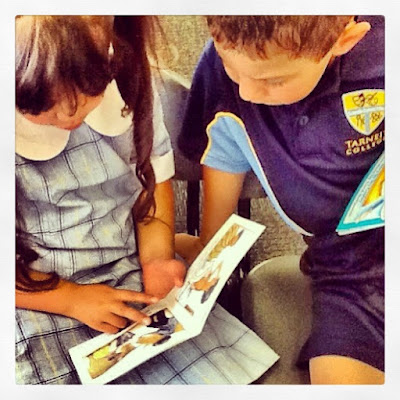Making Sense of Teaching With Mentor Texts
It all starts with selecting and sharing powerful texts and
simply letting kids enjoy them. Spread the joy of reading great words and what possibilities they spark in the mind of the reader. Reading a text for
enjoyment before you move to examining craft increases the likelihood of the
text impacting on a student’s writing. When the student knows the text, it releases their cognitive
energy more specifically to that aspect of the text under examination.
Think of mentor texts as a term that essentially means
–models, exemplars or examples. ‘Mentor texts’ is not something we do within a
writing program for its own sake. It is not an entity in itself. It is an
integral part of learning how to become a better writer. It requires the
ability to read like a writer in order to be able to see the potential in a text
to provide a model worth following or adopting.
We are looking for writing we want our students to emulate.
Our lens must be purpose and craft. So we need to select texts where we can
imagine students imitating the style of a particular author. If you imagine
your students saying, ‘I can do that!’ then you have discovered a text worthy
of adoption.
Choose a text to match a specific purpose. It may be an
investigation about punctuation, vocabulary, or dialogue. Make it something
your writer’s need to elevate their writing. Your assessment of student writing
will guide you in the right direction when looking for suitable texts.
Before any workshop read the selected text for familiarity
using a writer’s eye. Reading a text in this way takes practice. It is a skill
acquired over time, not overnight. Zoom in on something that will assist
students to write more effectively.
When presenting an exemplar you are rereading a portion of
the text for a specific purpose, rather than the entire text. Your teaching is
mindfully focused on that particular aspect of the text. This is the teaching
lens you adopt. It is helpful if you can name the craft move you are noting.
If you are a writer yourself, reading like a writer is
easier to master. You can’t escape it. It is something you feel compelled to do
in order to improve your own writing craft.
When presenting the lesson, read the extract for the beauty
of the language used. Show your admiration for the craft of the writer. Follow
this by considering specific writing moves you might try. Consciously use think
aloud to share what you have noticed the author do. Student writers need regular
exposure to this kind of thinking.
Ask students to consider why the author made this particular
move.
Using texts in this way involves a particular process. Students
do not learn these important crafting moves by osmosis, or some kind of magic. They
learn them through regular exposure and close examination provided by a writing
teacher. This is the responsibility of the most proficient writer in the room.
In time, student writers will hopefully begin to see the potential in texts
they are reading to influence the quality of their writing. Such an objective
should guide our teaching.
Teaching writing can feel isolating. It is comforting to
know you have so many other writers to support your efforts. Use the literature
created by others to inspire your students to lift their writing performance.
Gather around you texts written by authors you know and trust. When you acquire
your own collection of trusted texts you frequently discover a single text may
offer multiple instances for teaching aspects of writing. -Such a gift to your
teaching.
 |
| *The WHERE,WHERE, WHAT lead sued by Margaret Wild in her book, Tanglewood. |
In addition to this, take the opportunity to use student
written texts as exemplars. It shows them that sometimes they are writing in
similar ways to published authors. It expands the learning circle and provides
powerful motivation. Students are more likely to view themselves as writers if
we draw attention to such aspects of their writing.
Consider creating charts that document craft moves authors
(student and published authors) have used. This type of documentation provides
additional motivation to persist as a writer. And writing development relies
heavily on persistence. I learnt that from a mentor…








Comments
Post a Comment